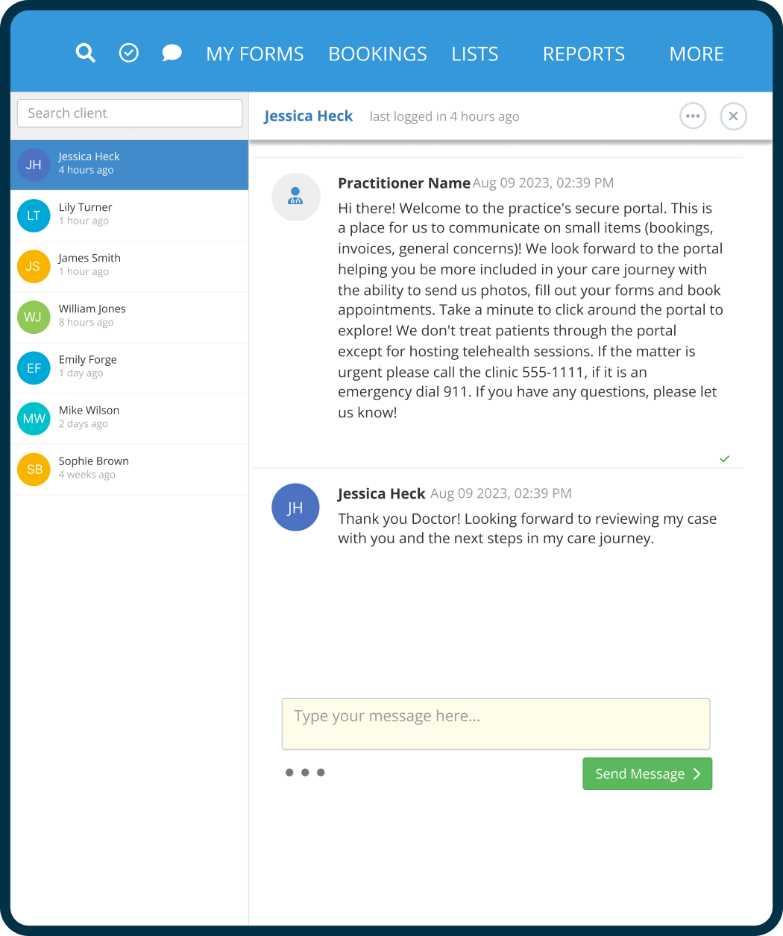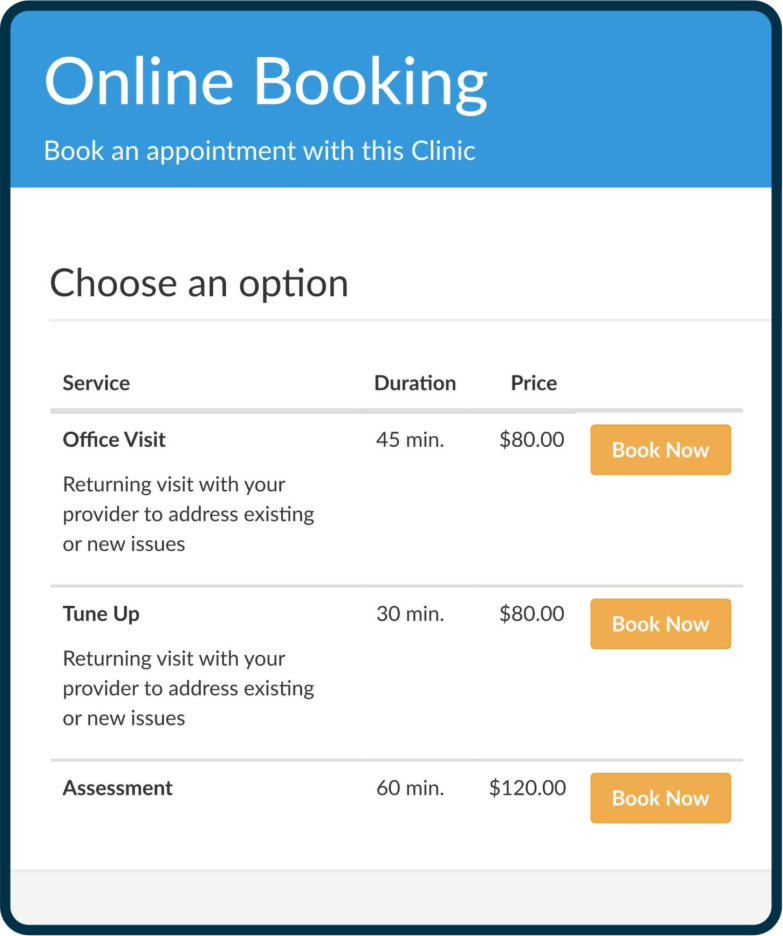Practical strategies to improve patient retention through better onboarding
Want to learn more about onboarding processes, watch our webinar: Scalable Trust: Systems That Build Rapport and Convert Patients Before Day One.
Key takeaways
- The first 30 days with a new patient are the most critical for retention and where most churn happens.
- Poor onboarding leads to wasted staff time, lost revenue, and preventable turnover.
- Strong onboarding builds trust, improves engagement, and creates the foundation for long-term patient loyalty.
- Best practices include clear communication, digital intake, proactive reminders, and billing transparency.
- PracticeQ gives practices the complete system to deliver seamless onboarding, reduce churn, and protect revenue from day one.
Patient onboarding is one of the most overlooked and critical moments in healthcare. The first 30 days are when patients decide if your practice feels organized, trustworthy, and worth sticking with.
Here’s the financial reality: acquiring each new patient requires a significant investment before they ever walk through your door. Depending on your market and specialty, that cost per lead can climb to $300—potentially costing thousands in wasted spend if patients don’t return.
If a patient doesn’t return after the first visit, you’ve sunk that investment with nothing to show for it. And you’ll have to spend even more money to backfill the gap.
That’s why onboarding can’t be treated like routine paperwork. It’s the first proof point of your ROI and a direct lever for retention. This guide will show you why the onboarding window matters and how to use it to improve retention from day one.
Why patient onboarding matters
So why is patient onboarding important? Because those first steps set the tone for everything that follows. Strong onboarding builds trust in your care, keeps operations running smoothly, and creates the foundation for long-term retention.
Trust and confidence are built early
Patients size up your practice fast. A clear, organized onboarding process signals competence and earns trust before the first visit even begins.
Patient engagement starts on day one
Engagement doesn’t start with treatment. It starts the moment a patient interacts with your intake and scheduling process. That’s where they learn whether you’ll make things easy—or add friction.
Retention hinges on first impressions
By the time care starts, most patients have already made their decision to stay or leave. Onboarding is where that impression forms.
The cost of a bad first 30 days
The first month with a new patient is your most expensive window. When onboarding breaks down, the fallout is immediate: patients slip away before loyalty forms, staff lose time chasing mistakes, and the money you spent to acquire those patients evaporates. On top of that, a single rocky experience can follow you in reviews and word of mouth long after the patient is gone.
Higher patient churn
When the onboarding experience is confusing or frustrating, patients often don’t come back. That early drop-off means you’ve lost the acquisition dollars you already spent and the long-term value of the relationship.
Wasted staff time and resources
When onboarding isn’t clear, your team ends up chasing down forms, clarifying next steps, or correcting scheduling errors. It’s rework that wastes hours and causes them to burn out, ultimately leading to turnover. A recent MGMA poll found that nearly a third of practices reported staff turnover was on the rise. For your practice, that kind of instability means constant retraining, higher labor costs, and an inconsistent patient experience when first impressions matter most.
Decreased revenue and lifetime value
Acquiring a new patient takes a real investment, often hundreds of dollars before they even arrive. When that patient doesn’t return, the loss includes both the upfront spend and the revenue they would have generated over months or years. Weak onboarding cuts into ROI and wipes out the long-term value of the relationship.
Negative reviews and word of mouth
Finally, the impact also shows up publicly. Patients who feel frustrated in their first 30 days rarely keep it to themselves. Negative reviews and casual word of mouth ripple outward, discouraging others from even booking with you.
What good onboarding looks like
A strong patient onboarding process sets clear expectations, makes the first steps easy, and removes friction that keeps patients from moving forward. These best practices create the foundation for long-term retention.
Clear communication and expectations
Patients want to know what to expect, and silence creates doubt. Confirming next steps (appointments, paperwork, treatment plans) cuts down on repeat calls and makes patients feel supported from the start.
Seamless intake and scheduling
If intake is clunky, patients notice. Digital forms eliminate handwriting errors, and online scheduling lets patients book at their convenience instead of calling the front desk. That combination saves staff time, reduces bottlenecks, and shortens wait times, creating a smoother first visit.
Proactive follow-ups and reminders
Patients are more likely to show up when you remind them. Automated texts and emails lower no-show rates, and a quick post-visit check-in reassures patients they’re not on their own. Both steps protect revenue and strengthen engagement.
Billing and payment transparency
Confusing bills erode trust faster than almost anything else. Showing costs before care begins, sending estimates electronically, and offering simple payment options prevent frustration and position your practice as straightforward and patient-focused.
Strategies to improve patient onboarding
Knowing what good onboarding looks like is one thing. Putting it into practice is where most clinics struggle. The solution isn’t to add more steps. It’s to strip away friction, support your staff, and guide patients with consistency from the start. These strategies show you how to do it.
Automate repetitive tasks
Front-office teams spend hours on things that don’t require human judgment, like reminders, unsigned forms, and insurance updates. Automating these touchpoints reduces errors and frees staff to focus on patients.
Practical steps:
- Set reminders that escalate with a three-day text, one-day email, and same-day text.
- Require digital forms to be submitted complete before scheduling.
- Auto-update insurance details through your PMS instead of manual entry.
The payoff is simple: less busywork, fewer mistakes, and more time for real patient care.
Personalize onboarding experiences
Automation doesn’t have to feel generic. Patients pick up quickly when communication sounds templated. A few small adjustments can make onboarding feel personal without adding extra work for staff:
- Use intake data to send resources that match the type of visit.
- Acknowledge first-time patients with a welcome message or quick overview of what to expect.
- Note preferences, like communication channel or referral source, so outreach feels familiar instead of scripted.
Personalization lowers anxiety, builds trust faster, and makes patients feel like you anticipated their needs.
Use digital tools for intake and communication
Paper slows everything down. Patients don’t want clipboards, and staff don’t want to retype forms. Online intake solves both by letting patients complete forms at home and sending data straight into the record.
In one survey of primary care patients, about 75% were comfortable with portals or email, and more than half preferred text messages from their doctor’s office. The takeaway is clear: patients expect digital options, and giving them those choices makes onboarding smoother for everyone.

Track engagement and refine workflows
Onboarding isn’t set and forget. Watch where patients drop off, whether it’s missed forms, unanswered reminders, or no-shows. Read those patterns as signals. Even simple tracking can reveal what needs fixing. You might find that patients ignore email but respond to text, or that certain appointment types have higher no-show rates. Adjusting your workflows based on those insights keeps the process improving instead of repeating the same mistakes.
Want to learn more about successful onboarding, watch our webinar with Dr. Elana Miller where she discusses systems that build trust early and help the right patients say yes to care.
The link between onboarding and retention
Patient onboarding doesn’t end after the first visit. The way you guide patients early on shapes whether they stick with your practice or quietly move on. Strong onboarding creates the confidence and consistency that turn new patients into long-term relationships.
Patients who feel supported stay longer
When patients know what to expect and feel cared for from the start, they’re more likely to follow through on treatment and return for future visits. Early support signals reliability.
Smooth workflows create trust
Delays, errors, and repeated questions erode confidence. A smooth onboarding process shows patients that your team is organized, which builds trust that lasts beyond the first appointment.
Consistent engagement prevents drop-off
Retention depends on steady touchpoints. Proactive reminders, follow-ups, and clear communication keep patients connected and less likely to disappear after a visit.
Why PracticeQ is built for patient onboarding
The first 30 days decide whether patients stay or slip away. Strong onboarding builds trust, keeps schedules intact, and sets up long-term loyalty. PracticeQ is built to give practices the tools to get those days right and stop losing revenue to preventable churn.
Online intake and scheduling tools
Patients complete intake before they arrive, so nothing is missed and data flows straight into the chart. Scheduling happens in the same system, letting patients book online while your staff avoids endless back-and-forth calls.

Automated reminders and communication
No-shows and missed forms drain revenue. PracticeQ automates reminders by text and email so patients know what to do next, and your team isn’t stuck chasing confirmations.
Integrated billing and payments
Billing surprises can undo the goodwill of a first visit. PracticeQ integrates invoicing, payments, and reminders so costs are clear upfront. That transparency builds trust and steadies cash flow from day one.
Workflow automation for staff efficiency
With PracticeQ, the process runs itself. Intake can trigger reminders, incomplete forms flag automatically, and billing workflows launch without staff intervention. The result is fewer patients slipping through the cracks and more time for your team to focus on care.
Ready to see how smoother onboarding can reduce churn and protect revenue? Start your free trial of PracticeQ and turn first visits into lasting relationships.
Patient onboarding FAQs
What is patient onboarding in healthcare?
Patient onboarding is the process of welcoming new patients, gathering their information, and setting clear expectations for what comes next. Done well, it creates a smooth start that builds trust from day one.
Why is the first 30 days so important for retention?
The first month shapes how patients feel about your practice. A smooth experience builds confidence and keeps them coming back, while a rocky one often leads to drop-off.
How can software improve patient onboarding?
Software takes repetitive tasks off staff plates, reduces errors, and makes communication easier for patients. The result is a faster, clearer process that feels more professional and reliable.
What’s the most common onboarding mistake practices make?
The biggest mistake is leaving patients guessing. When communication is unclear or paperwork is confusing, patients feel unsupported before care even begins.
Can better onboarding really reduce churn?
Yes. When patients feel guided and supported, they’re far more likely to return and stay loyal. Good onboarding prevents early drop-off and protects the investment you made to acquire that patient.
Baum, MD, N. (2024, October 18). Marketing 2.0: Determining the cost per lead and the lifetime value of patients. Physicians Practice. https://www.physicianspractice.com/view/marketing-2-0-determining-the-cost-per-lead-and-the-lifetime-value-of-patients
Fridman, I., Smalls, A., Fleming, P., & Jennifer Elston Lafata. (2023). Preferences for Electronic Modes of Communication Among Older Primary Care Patients: Cross-sectional Survey. JMIR Formative Research, 7, e40709–e40709. https://doi.org/10.2196/40709
Harrop, C. (2024, September 15). Can staff turnover continue to be tamed in medical practices into 2026? Medical Group Management Association (MGMA). https://www.mgma.com/mgma-stat/can-staff-turnover-continue-to-be-tamed-in-medical-practices-into-2026
McCarthy, D. (2025a, August 1). 3 Major Benefits of Automated Appointment Reminders Software. PracticeQ. https://www.practiceq.com/resources/benefits-automated-appointment-reminders
McCarthy, D. (2025b, August 1). 10 Med Spa Software Tips to Boost Client Retention. PracticeQ. https://www.practiceq.com/resources/med-spa-software-tips-client-retention

.jpg)
